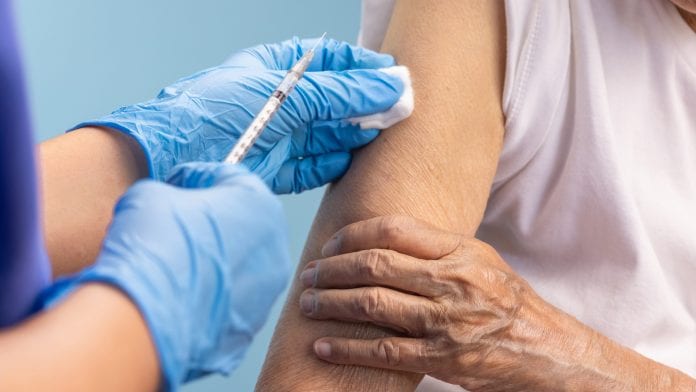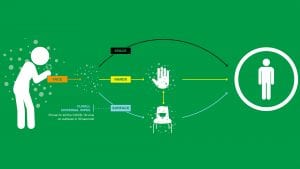
Throughout the COVID-19 pandemic, European governments have encouraged us to stay well apart – so how can we now come together to safely roll out vaccination programmes across the continent?
COVID-19 vaccination programmes face a unique challenge. If they are to be effective, they need to vaccinate a huge volume of people in a very short space of time. Given that the majority of our public health interventions pertaining to the COVID-19 pandemic have focused on keeping people apart to limit the spread, governments are now faced with a delicate balancing act.
If people attending vaccination centres will be receiving a vaccine, do we really need to worry about them catching the virus? Unfortunately, yes. We know that no vaccine is 100% effective, and no vaccine is effective immediately. Research published in The Lancet suggests that the first dose of the Pfizer-BioNTech is only 30% effective for the first 14 days following vaccination (followed by an increase to 75% effective for days 15-28);1 and similar timeframes are estimated for the other vaccines. Without proper infection prevention and control (IPC) measures in place, vaccination centres could provide an ideal route for the virus to spread. However, by understanding how COVID-19 spreads, and how we stop it, governments can begin to tip the balance in their favour.

How COVID-19 spreads
COVID-19, like a whole raft of other common respiratory infections, spreads primarily through droplet transmission. In the real world, this means that infectious droplets will either transmit the virus to someone directly (if they are in close enough proximity) or take an indirect route by contaminating hands and surfaces.
Why surface disinfection matters
Surfaces play an important, but often overlooked, role in transmission. When healthcare workers touch surfaces in the patient’s environment, they are just as likely to pick up harmful microorganisms on their hands as if they have touched the patient directly.3 We know that improving surface disinfection dramatically reduces the spread of harmful microorganisms between patients.4 If we are going to stop the spread of COVID, improving surface disinfection will have to be part of it.
What makes a good disinfectant?
Not all disinfectants are created equal. In fact, there are huge differences in the way they act, the types of organisms they are effective against and how quickly they work. We developed Clinell Universal Wipes to overcome the drawbacks associated with traditional disinfectants. Founded by two medical doctors based on their clinical experience, GAMA Healthcare is a dedicated infection prevention company, specialising in manufacturing IPC products that make a difference in the real world.
Efficacy against one particular strain of virus or bacteria does not guarantee effectiveness against another. Whilst many disinfectants claim to offer blanket coverage against ‘99.9% of bacteria and viruses’, different organisms can exhibit very different tolerance to disinfectants. Rather than simply testing against a surrogate, Clinell Universal Wipes have been proven by an accredited third-party laboratory to kill the actual COVID-19 virus (SARS-CoV-2) on surfaces in just 30 seconds.
For each organism type, all disinfectants have a ‘contact time’: the time which the surface needs to be wet for the disinfectant to kill the organism in question. Many disinfectants require a surface to be wet for five minutes or more. While that process may work in a lab, it is a luxury we cannot afford when trying to vaccinate as many people as possible. Clinell Universal Wipes are formulated to achieve realistic contact times, killing 99.999% of bacteria in under 20 seconds and killing SARS-CoV-2 within 30 seconds.
Finally, there is the issue of pre-cleaning. Traditional chlorine-based disinfectants require the surface to be cleaned first; and many disinfectants cannot remove dirt, blood and contamination. To make matters worse, that contamination stops traditional disinfectants from working.5 Clinell Universal Wipes clean and disinfect in a single step, removing the need for pre-cleaning and saving staff time during tight turnarounds. Moving from separate cleaning and disinfection to using Clinell Universal Wipes removes the risk of staff error and, in one study, reduced the rate of MRSA acquisition by 55%.4
Nine out of 10 UK NHS hospitals use Clinell products, which are sold in over 70 countries and have been a constant sight throughout the UK’s vaccination rollout. But picking an effective product is only half the battle.
Clean Between to stop the spread of infection
In 2019, GAMA Healthcare ran dozens of ‘Clean Between’ events in NHS Trusts across the UK. The events engaged staff, raising awareness about the impact of surface disinfection and educating them on infection prevention best practice. After the events, local infection prevention and control teams were equipped with the materials and resources they would need to turn the launch events into organisation-wide campaigns.
Clinell, COVID, and Clean Between
“The challenge is that healthcare staff are under pressure like never before,” says Dr Guy Braverman, joint CEO and co-founder of GAMA Healthcare. “They know that surface disinfection is important, it’s just hard to keep it at the top of their minds when they’re so stretched. Many of our customers asked us to bring back the Clean Between campaign to help with COVID and the vaccine rollout. With live events posing a challenge, we’ve focused on providing amazing awareness and education materials for organisations to run their own campaigns.”
Joanne Reynard, Community Infection Prevention Nurse, comments: “As a community infection prevention nurse, I’ve always suggested that Clinell Universal Wipes are used when working in potential COVID areas; as I know that it meets the European standards EN 14476 and it’s the easiest product to use. I tell my teams one wipe at a time, open it and wipe top to bottom, clean to dirty. This helps lots of volunteers clean and keep our environment safe during busy vaccination sessions.”
The new Clean Between campaign places emphasis on cleaning surfaces between patients. The materials suggest use of Clinell Universal Wipes, proven to kill the actual COVID-19 virus in 30 seconds.
For more information, speak to your local GAMA Healthcare Area Manager or visit www.cleanbetween.net.
References
1 Amit et al. Lancet. 2021;6736(21):18-19.
2 Riddell et al. Virol J. 2020;17(1):145.
3 Hayden et al. Infect Control Hosp Epidemiol. 2008;29(2):149-154.
4 Garvey et al. Antimicrob Resist Infect Control. 2018;7(1).
5 Humphreys et al. J Infect Prev. 2013.
This article is from issue 17 of Health Europa. Click here to get your free subscription today.








